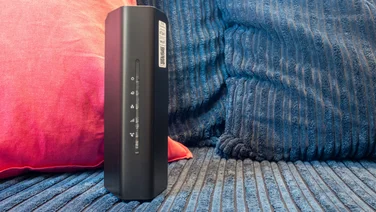To help us provide you with free impartial advice, we may earn a commission if you buy through links on our site. Learn more








- Terrifically competitive price
- Fast enough for domestic use
- Nice compact design
- “AI” features are mostly fluff
- Faster, more flexible routers don’t cost much more
The name makes it sound like a jet fighter, but the D-Link R15 Eagle Pro AI is a decidedly down-to-earth proposition. It’s one of the smallest Wi-Fi 6 routers we’ve seen and also one of the cheapest, so it will slot right into a home or small office without intruding on your workspace or your budget.
While the design is modest, the Eagle Pro boasts special AI optimisations that can help performance and, if you need to extend your coverage, it can pair with other D-Link routers and extenders to form the hub of a mesh network. The big question is how well it all works – and whether there’s any reason to pay more for a Wi-Fi 6 router.
D-Link R15 Eagle Pro AI review: What you need to know
The R15 Eagle Pro AI is a dual-band Wi-Fi 6 router. It doesn’t claim to provide the fastest wireless performance on the block but it supports 4×4 MU-MIMO and the 5GHz radio offers connection speeds of up to 1.2Gbits/sec, so there’s no obvious reason why this router shouldn’t match the performance of much more expensive models.








The top speed on the 2.4GHz band is a rather slower 300Mbits/sec but that’s unlikely to be a problem, as nowadays these channels are mostly only used by IoT gadgets and appliances that don’t need top performance.
If you’re looking for multi-Gigabit Ethernet, versatile USB connectivity or compatibility with the latest Wi-Fi 6E devices then, guess what, this isn’t the router for you. But for basic wired and wireless networking it ticks all the important boxes and even adds a few upmarket features such as flexible QoS controls and an inbound VPN server.
READ NEXT: Browse with security with our best VPN picks
D-Link R15 Eagle Pro AI review: Price and competition
At a mere £67, the D-Link R15 Eagle Pro AI is one of the cheapest Wi-Fi 6 routers we’ve ever tested. It vies for that title with the TP-Link Archer AX10, which at the time of writing was two pounds cheaper on Amazon. That router has almost identical specifications to the Eagle Pro but, as we’ll see below, the performance profiles of the two routers are a little different.
For very little more you could also consider the TP-Link Archer AX53 or the Linksys MR7350 (£75). Both models again match the Eagle’s 1.2Gbits/sec speed rating on the 5GHz band, and the Linksys adds a USB 3 port for convenient file sharing.
No matter which manufacturer you choose, you won’t get top-tier speeds from a sub-£100 router. If that’s what you want, our best-value recommendation is the Asus TUF Gaming AX5400. As the tables below illustrate, this sits in a different performance class to any of the routers mentioned above but, at £168, it’s also in a different price bracket.
Still, you can spend far more on a router if you’re so inclined. The Asus ROG Rapture GT-AX6000 is a real Wi-Fi 6 speed demon, and has a good set of gaming features, too – as it should do for a stiff £340. And our current favourite pick of the premium routers is the Netgear Nighthawk RAXE500, which includes support for Wi-Fi 6E and numerous premium features, all for a bargain £550.
D-Link R15 Eagle Pro AI review: Design and features
The R15 Eagle Pro AI is pleasingly compact, with a footprint of just 195 x 139mm and a futuristic angular design that’s not unpleasant to look at. The height of the four antennas perhaps throws off the visual balance, but we’re not complaining about that as bigger aerials normally mean better coverage.
At the front of the R15 Eagle Pro AI four LEDs show the state of the power and internet connections, plus the two wireless bands. At the back sit four Gigabit Ethernet sockets, although one of these connects to your internet modem, so only three ports are available for wired clients. Next to it are a WPS button and a recessed reset button. That’s about it for the physical design, save for one nice feature: the size and simple design of this router make it suitable for hanging on a wall, and two mounting holes on the bottom make that very easy to achieve, merely requiring two screws of the appropriate size.








While the hardware is quite basic, the software has a few clever features. As is the norm these days, D-Link uses a standard firmware platform across almost all its routers, so the cheapest models have many of the same capabilities as the pricier ones. In this case, that means you get a configurable SPI firewall and an inbound VPN server that enables easy, secure access to your home network over the internet. There’s also a visual manager with the nice option to temporarily boost a device’s priority for a set time, and mesh support for managing D-Link’s E15 plug-socket Wi-Fi extenders and other compatible devices.
The trumpeted “AI” features are a bit of a letdown, however. Their functions are decidedly mundane, and frankly there’s not much intelligence to any of them. The automatic Wi-Fi Optimiser merely takes care of selecting the clearest channel for your wireless connection, while the AI Assistant simply generates reports of your internet usage. The Traffic Optimiser applies gentle throttling to bandwidth hogs, so that other clients aren’t crowded out.
The biggest disappointment is “AI Parental Control”. I was hoping for smart filters that could identify and categorise online content but the controls you get are as dumb as can be. You can set schedules and time limits for kids’ devices but if you want to block inappropriate websites you have to enter the details by hand. Since a maximum of 24 keywords can be entered, it’s effectively impossible to shut off anything more than a tiny corner of the web.








Alongside the standard web console, you can use D-Link’s Eagle Pro AI mobile app to manage your network. This lets you check in on your router over the internet, access the parental control and QoS features and enable a few basic voice commands via Alexa and the Google Assistant. Switching between the app and the browser interface can be disorienting, though, as the layout and presentation are completely different.
READ NEXT: Our roundup of the best wireless routers
D-Link R15 Eagle Pro AI review: Performance
If you’ve read one of these router reviews before, you’ll know exactly how I tested the R15 Eagle Pro AI’s performance. First, I set up the router in my study at home and installed the latest firmware. I then attached an Asus Drivestor 4 Pro NAS to one of the router’s Ethernet ports, and connected wirelessly to the router, on the 5GHz band, from a test laptop equipped with an Intel AX210 2×2 Wi-Fi 6 card.


I then carried the laptop to various parts of my home and tested upload and download speeds to and from the NAS. Here are the results I obtained, in megabytes per second, along with the speeds from the other routers mentioned above for comparison.While the R15 officially claims the same 5GHz connection speeds as rivals from Linksys and TP-Link, in real-world use it turns out to be one of the slowest Wi-Fi 6 routers we’ve seen. It did deliver better short-range download performance than the Archer AX10, but even that saving grace fell away once I moved out to the kitchen, bedroom and bathroom.
Of course, I didn’t expect premium performance from a router that costs this little. It’s hardly shocking that the R15 can’t keep up with an Asus router that’s more or less twice the price. What’s embarrassing for the R15 Eagle Pro AI is that it’s so comprehensively smashed by the Linksys MR7350: that router costs a mere £8 more, yet nearly tripled the Eagle’s download speeds in hard-to-reach locations.
Let’s keep things in perspective, though. Netflix recommends that to stream 4K video, your internet connection needs a download speed of at least 5Mbits/sec – equivalent to around 0.6MB of data per second. Even at its worst, the R15 managed more than 16 times this speed. For everyday internet tasks, this router is far more than fast enough.
READ NEXT: Get the most out of your router with the best broadband providers
D-Link R15 Eagle Pro AI review: Verdict
The R15 Eagle Pro AI isn’t exactly a standout router, in terms of either features or performance. Within the same price range you can get much faster speeds from the Linksys MR7350, not to mention a handy USB socket. TP-Link’s similarly priced Archer models offer far more impressive security and parental control features.
That’s fine, though, because the R15 isn’t supposed to stand out. It’s clearly intended to provide a usable wireless internet connection with a minimum of fuss, and on those terms it’s hard to criticise. It’s not the right fit for power users, nor for anyone who cares about bandwidth – whether that’s downloading from the internet or moving data around your home network. But homes and offices of modest size and with modest needs don’t need to spend any more – this simple and very affordable router knows its role and fulfils it admirably.







